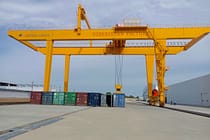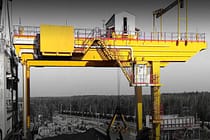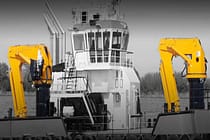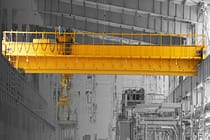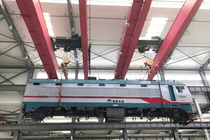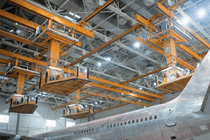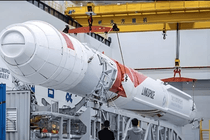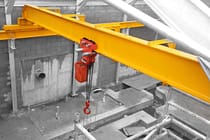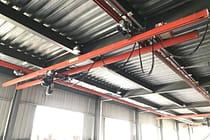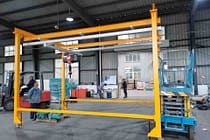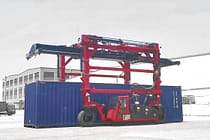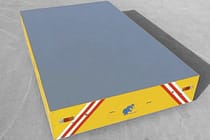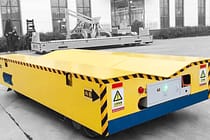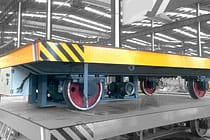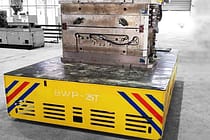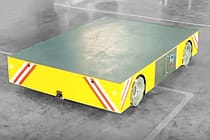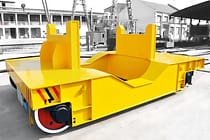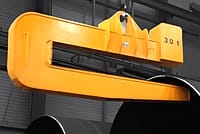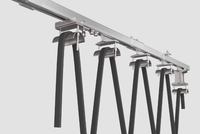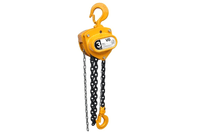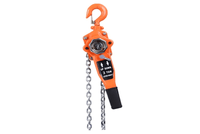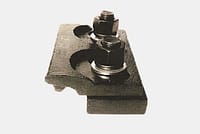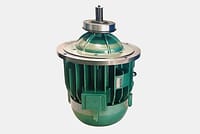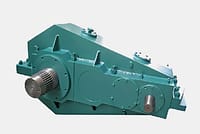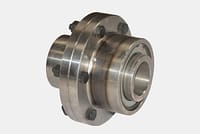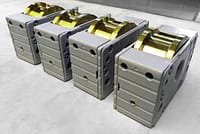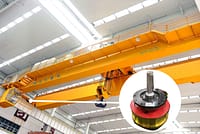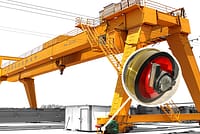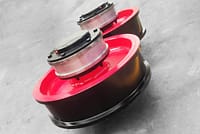天井クレーンの異常な騒音: 5 つの一般的な原因と効果的な修理ソリューション
目次
天井クレーンの異常な騒音は、橋形クレーンの操作においてよくある問題です。この記事では、天井クレーンの操作における異常な騒音の原因を分析し、クレーンの移動機構、クレーンレール、クレーンランウェイガーダー、基礎沈下、電気システムの 5 つの潜在的な要因を挙げています。また、挙げられた騒音問題に対する解決策もいくつか紹介し、皆さんのお役に立てれば幸いです。
天井クレーンの異常騒音原因の分析
なお、本稿で述べる異音は、車輪、駆動機構、モーターなどの部品を交換していない、元の状態の天井クレーンについて述べたものであり、クレーン設備の交換によって発生する異音については本稿の対象外とする。
1. 天井クレーン走行機構の原因
(1)クレーンホイールの原因
実際のアプリケーションでは、クレーンの車輪によって発生する天井クレーンの異常な騒音は一般的であり、主な原因は次のとおりです。
- 車輪の水平方向または垂直方向のずれが過度に大きいため、クレーン操作中に車輪とレールの間で常に摩擦と衝突が発生します。
- ホイールベアリングの潤滑不良により走行抵抗が増加し、ベアリングが損傷して固着や異音が発生します。
- ホイールフランジとクレーンランウェイレールの過度の摩耗。
(2)ガイドホイールの原因
クレーンのガイドホイールは、クレーンまたはトロリーが正しい方向に軌道を維持するのに役立つ垂直軸を備えたホイールです。ガイドホイールの不適切な取り付けまたは調整により、ガイドホイールとクレーンレールの間で摩擦または衝突が発生し、異常な騒音が発生する可能性があります。図 1 に示すように、ガイドホイールの摩耗は非常に深刻になる可能性があります。
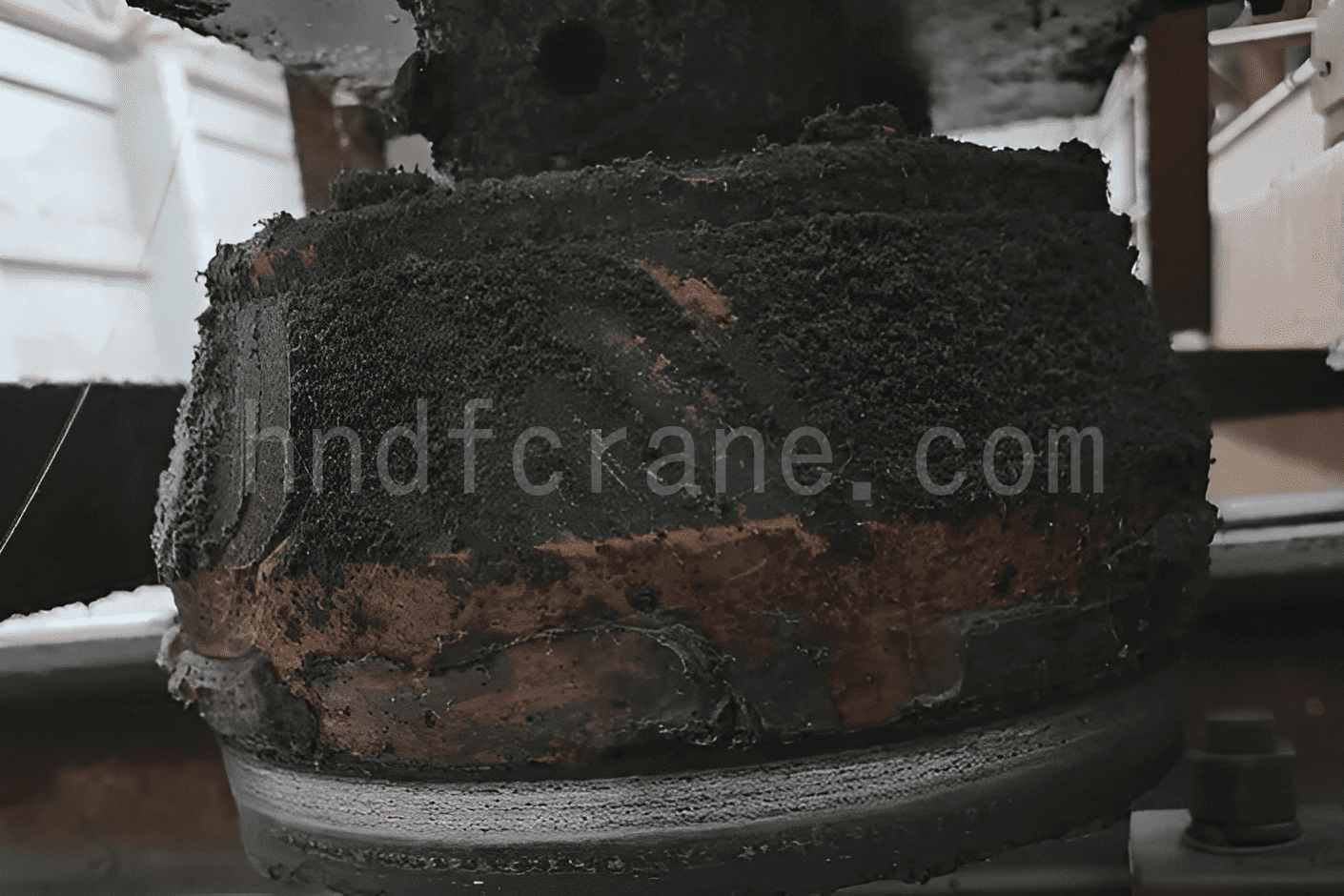
(3)駆動機構の原因
この記事で取り上げるクレーンの駆動機構は、「3 in 1」駆動機構を例にしていますが、別々に配置されたシステムも参照できます。駆動機構の異常なノイズの主な原因は次のとおりです。
- 「3 in 1」減速機からの異常なノイズ、ギアの摩耗、または歯の破損。
- 2 つ以上のブレーキが同期していない、損傷している、または欠落している (図 2 を参照)。
- 摩耗したバッファパッド(図 3 を参照)。
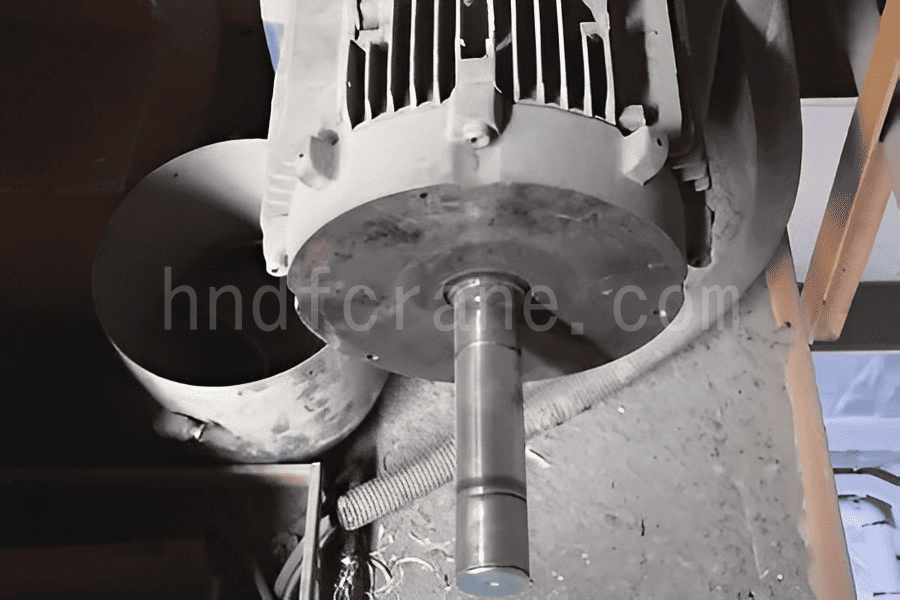
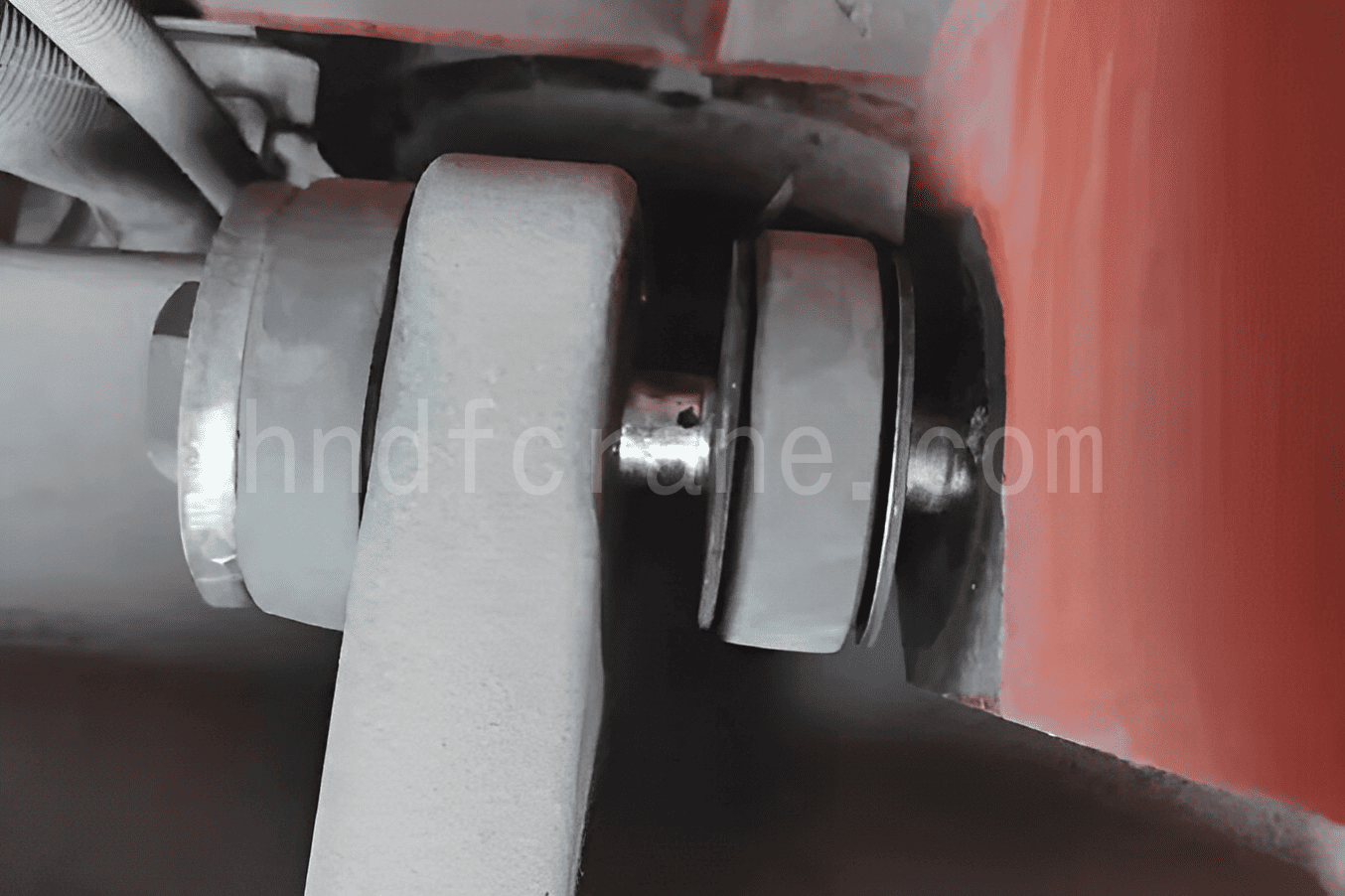
(4)クレーン主桁の故障原因
クレーンの主桁が原因でクレーン走行機構に異常な騒音が発生する主な原因は次のとおりです。
- クレーンの主桁の水平方向の曲がりが大きくなり、斜めのずれが生じます。
- 主桁のキャンバーが大幅に変化し、クレーンのホイールベースに変化が生じます。
2. クレーンレールの原因
クレーンを長時間操作すると、特に全負荷状態では、レールにかかるストレスが増加し、クレーン操作中に異常な騒音が発生する可能性があります。メンテナンスが不十分な場合、問題はさらに顕著になる可能性があります。レールに関連する異常な騒音の主な原因は次のとおりです。
- レールクランプナットの締め付け不足または緩み(図4参照)、緩んだ部分でレールが変形し、クレーン移動時に異常な騒音が発生します。
- レールとクレーンガーダーの間に過度の隙間がある、シムプレートが欠落しているか不適切に配置されている。
- 継目板で連結されたレール継ぎ目の上下方向のずれが許容値を超えており、研磨や調整が行われていないため、クレーンが通過する際に異常な騒音が発生する。
- フィッシュプレートで接続されたレールジョイントの水平方向のずれにより、異常な騒音が発生します。フィッシュプレートの接続部に過度の隙間があります (図 5 を参照)。
- 溶接されたレールジョイントの継ぎ目の滑らかさが不十分で、ひび割れやジョイントの剥離が発生します。
- レールクランプが欠落しているため、異音が発生します。
- レールの長さに沿った水平または垂直の位置合わせの過度の偏差。
- 許容偏差を超えるレールスパン。
- 2 本の平行レールの上部の高さの差が大きすぎる。
- 2 本の平行レール間のレール接合位置の縦方向オフセットが正しくないか不十分です。
- レール側面の摩耗がひどい。

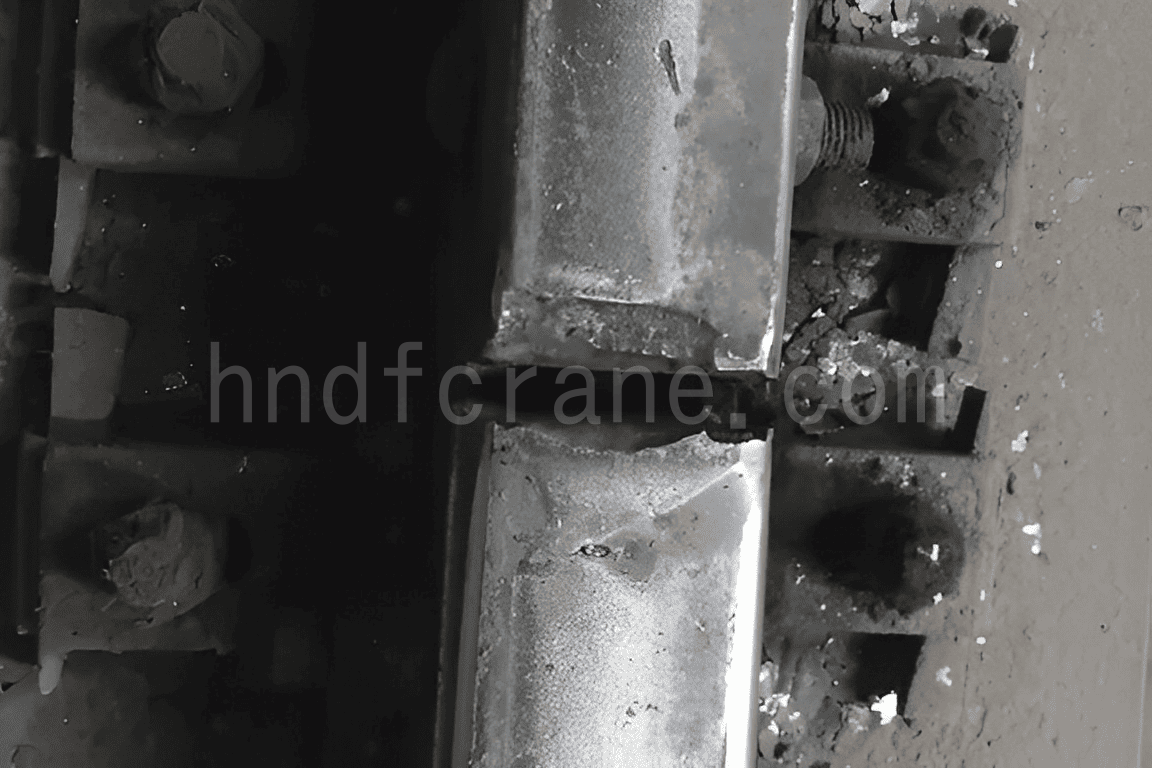
3. クレーンランウェイガーダーの原因
- 鋼製滑走路桁の下方への過度のたわみ、または桁の横方向の曲がり。
- 滑走路桁のジョイントが緩んでいます。
- 滑走路桁を接続するボルトが緩んでいるか、欠落している。
- 隣接する桁間の高さの差が大きすぎる(図6参照)。
- コンクリートクレーンガーダーとレール間のコンクリートグラウト層またはレベリング層の亀裂または破損。

4. 基礎沈下の原因
基礎沈下とは、土壌層が付加的な応力を受けて圧縮され、表面沈下を引き起こすことです。過度の沈下、特に不均一な沈下は、建物の傾きやひび割れを引き起こし、使用不能になることがあります。基礎沈下は、工場構造全体に関連する一般的な問題です。数メートルの小規模な局所沈下から、数十メートルの大規模な全体沈下までの範囲があります。
局所的な沈下により、ランウェイ ガーダーの一部が沈下し、沈下したガーダーとクレーン レールの間に隙間が生じます (図 7 参照)。この隙間によりレールにかかる応力が増大し、クレーン操作時に異常な騒音が発生します。適切な補修と改善が行われない場合、影響を受けた領域のクレーン レールに永久的な変形や損傷が生じる可能性があります。
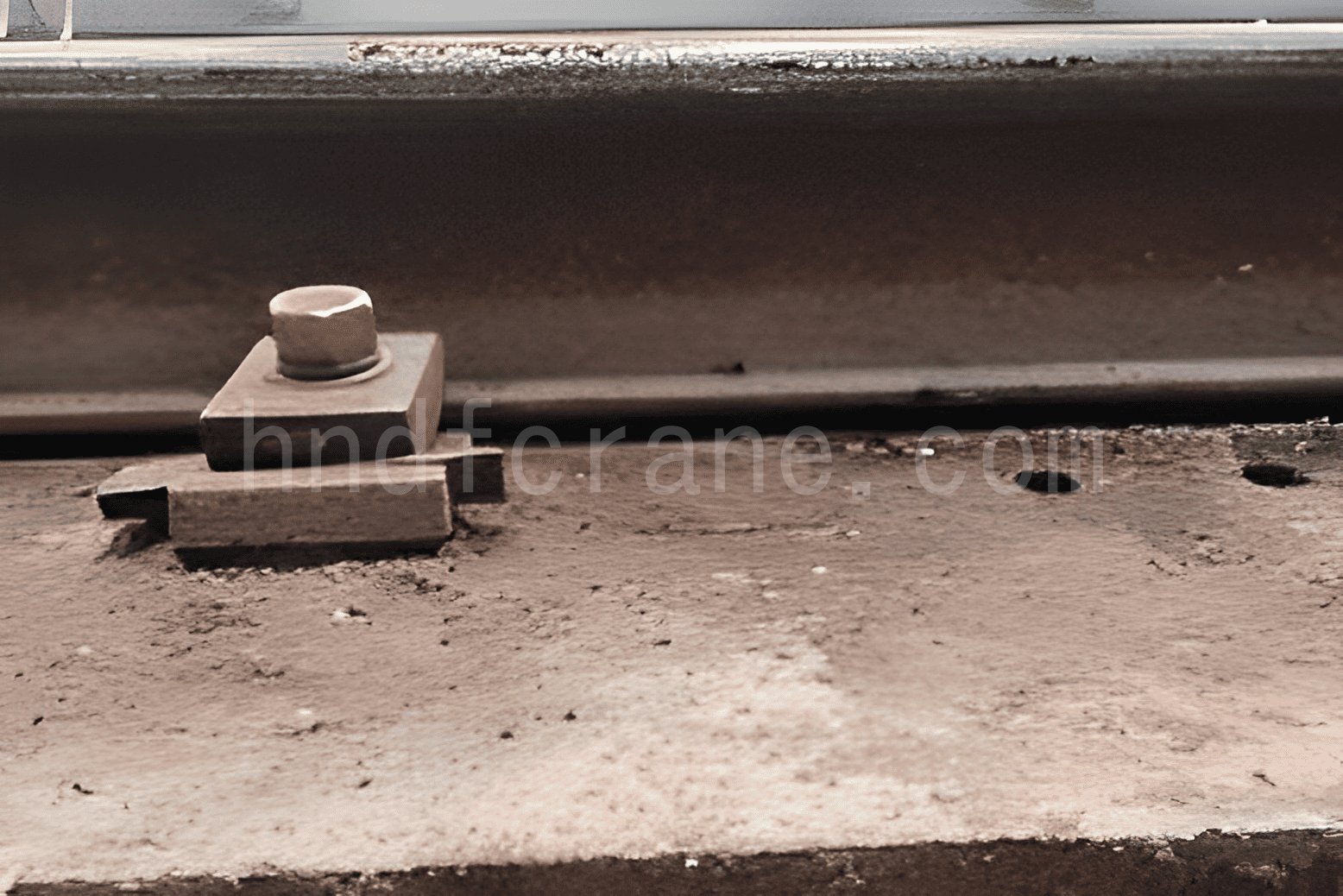
全体沈下は基礎沈下のより深刻な形態であり、滑走路桁の大規模な沈下を引き起こします。沈下の不均一性により、滑走路桁の高さのばらつきや水平方向の変形が生じ、クレーンレールの対応する垂直方向または水平方向の変形を引き起こします。クレーン操作中に異常な騒音がさらに顕著になり、高速操作が困難または不可能になります。
5. 電気的な原因
クレーン操作中に天井クレーンの異常なノイズが発生するほとんどのケースは機械的な問題が原因です。ただし、電気的な要因も原因となる場合があります。これには、モーターやブレーキ配線の緩みや接続不良、ブレーキ パッドの損傷や摩耗などが含まれます。
天井クレーンの異常騒音に対する解決策
天井クレーン操作時の異常騒音の各原因には、対応する解決策が示されています。
1. クレーン走行機構ソリューション
(1)クレーンホイールソリューション
- 水平または垂直方向のずれが過度に発生する問題については、 クレーン車輪調整量をまず測定する必要があります。 14405-2011 国際電気標準会議 (IEC) 14405-2011、測定値に基づいて調整を行います。水平方向のずれを調整する場合は、ホイールセットの垂直面にシムを配置し、垂直方向のずれの場合は、水平面にシムを配置します。調整後、試運転を行い、クレーンの車輪とレールの隙間を確認します。
- ホイールベアリングの潤滑不良により走行抵抗が増大する問題については、潤滑グリースを速やかに補充する必要があります。その後、ベアリングの柔軟性を確認するテストを実施します。ベアリングの損傷により固着や異常なノイズが発生する場合は、さらなる問題を防ぐためにベアリングを直ちに交換する必要があります。
- クレーンのホイールフランジとレールの過度の摩耗については、まず過度のホイールのずれやレールの不適切な取り付けなど、摩耗の原因を調査します。ホイールフランジの通常の摩耗はそのまま放置できますが、摩耗がフランジの設計厚さの 40% を超える場合は、ホイールを交換する必要があります。
(2)ガイドホイールソリューション
ガイドホイールの不適切な取り付けや調整によって異音が発生した場合は、ガイドホイールとレールの隙間を調整して、クレーン操作中に隙間がないか、摩擦や衝突が最小限であることを確認します。位置決めブロックが適切かどうかを確認し、適切でない場合は再調整します。GB/T 10183.1-2018 を参照して、クレーンレールに垂直な方向とクレーンレールに沿った方向の両方で水平ガイドホイールの軸平行度許容差と高さ許容差を確認します。実際の値が許容差を超える領域を調整します。
(3)駆動機構ソリューション
- 「3 in 1」減速機から異常なノイズが発生した場合は、ノイズの発生箇所を点検してください。ギアが摩耗していたり、歯が折れている場合は、ギアを交換する必要があります。
- 2 つ以上のブレーキが同期していない場合は、ブレーキが正しく機能しているかどうかを確認します。隙間ゲージを使用してブレーキの隙間を測定し、必要な仕様を満たしていることを確認します。満たしていない場合は、それに応じて隙間を調整します。
- ブレーキやバッファーパッドが損傷している場合は交換し、定期的な点検を行う必要があります。
(4)クレーン主桁ソリューション
クレーンの主桁は、通常、変形しにくい構造です。変形が発生した場合は、設計が適切かどうか、製造が設計要件を満たしているかどうか、製造プロセスが建設基準に従っているかどうか、クレーンの設置が標準に準拠しているかどうかを確認する必要があります。主桁の過度の水平曲がりやキャンバーの大幅な変化などの問題に対しては、溶接部の補強や火炎加熱などの修復方法が一般的に使用されます。修復には通常、製造元または専門チームの関与が必要です。主桁の検査は、GB/T 14405-2011 を参照して実施できます。
2. クレーンレールソリューション
クレーンレールの取り扱いでは、定期的なメンテナンスと保守に重点を置き、問題を早期に解決して機器の損傷を防ぐ必要があります。
- レール クランプ ナットが十分に締められていない、または緩んでいるという問題については、定期的な検査と計画的なメンテナンスを組み合わせて、ナットが適切に締められていることを確認する必要があります。
- レールとランウェイ ガーダーの隙間が大きすぎる場合、または隙間の長さが長すぎる場合は、鋼製ランウェイ ガーダーを調整して、レールの下部をガーダーの上部に近づけます。隙間が 200 mm を超える場合は、長さが少なくとも 100 mm、幅がレール ベースより 10 ~ 20 mm 広いシム プレートを使用します。1 セットあたり 3 枚を超えるシム プレートは使用せず、鋼製ガーダーにしっかりと溶接する必要があります。コンクリート ビームの場合も、鋼製ビームと同様の方法を使用します。弾性シム プレートは、時間の経過とともに頻繁に摩耗するため、推奨されません。
- 継目板レール接合部の垂直方向または水平方向のずれが過度に大きい場合は、継目板の摩耗を確認してください。過度の摩耗が見つかった場合は、継目板を交換します。次に、レール接合部とレールを調整して、垂直方向と水平方向のずれが 1 mm を超えず、レール接合部の隙間が 2 mm を超えないようにします。温度差が 20°C 以上ある地域や冬季の設置では、接合部の隙間を 4 ~ 6 mm にしてください。測定には、スチール定規と隙間ゲージを使用してください。
- 溶接レールジョイントの滑らかさが不十分な場合は、研削ホイールを使用してジョイントの上部と側面を滑らかにし、必要なレールジョイント基準を満たします。溶接レールジョイントが割れたり緩んだりする問題については、特定の材料とプロセスを備えた専門の溶接担当者が修理を行う必要があります。クレーンレールシステムは複雑なため、溶接後に割れたり緩んだりするリスクが依然としてあります。したがって、橋形クレーンのレールジョイントには溶接ではなく、継ぎ目板接続が推奨されます。
- レールクランプの欠落により異常なノイズが発生する場合は、欠落している部品がないか確認し、それらを固定してクレーンが正常に動作するようにして下さい。
- レールの長さに沿って過度の水平または垂直の曲率偏差がある場合は、2メートルの長さにわたる水平偏差が1mmを超えず、垂直偏差が2mmを超えないようにレールを調整します。測定は鋼線法を使用して実行できます。
- クレーンレールのスパン偏差が許容範囲を超える場合は、最大許容スパン偏差 ΔS が次のようになるようにレールを調整します。
- S≤16mの場合、△S =±5mm
- S>16mのとき、△S =±[5+0.25(S-16)]mm
- ΔS: クレーンレールスパン偏差
- S: クレーンレールのスパン
- 最大偏差は±15 mmを超えてはなりません。具体的な実施については、GB/T 10183.1-2018を参照してください。クレーンレールのスパンは、スチールテープとスプリングスケールを使用して測定できます。
- 2 本の平行なクレーン レールの上部の高さに過度の差がある場合は、ランウェイ ガーダーとレールを調整して、高さの差が 10 mm を超えないようにします。レベルを使用して、複数の測定値を取得します。
- 平行レールジョイントが縦方向にずらされていないか、ずらし距離が正しくない場合は、距離が 600 mm 以上であり、クレーンの前輪と後輪のホイールベースと一致しないようにレールを調整します。
- レール側面の摩耗が元のレール幅の15%を超える場合は、レールを交換する必要があります。
3. 滑走路桁ソリューション
滑走路桁の品質は、レールの設置品質を保証する基礎です。レールを設置する前に、滑走路桁の設置偏差が要求基準を満たしていることを確認することが重要です。レールを設置する前に滑走路桁の詳細な検査を実施し、検査中に滑走路桁の基準線をマークする必要があります。これはセオドライトを使用して測定でき、レベルは水準器を使用して測定できます。
鋼製滑走路桁の受け入れは GB 50205-2017 に従う必要があり、鉄筋コンクリート製滑走路桁の受け入れは GB 50204-2015 に従う必要があります。現在、ハイブリッド鋼コンクリート滑走路桁に関する特定の規格はありません。
- 鋼製滑走路桁の過度の下方向のたわみや横方向の曲がりなどの問題については、設計が要求される基準を満たしているか、設置が適切であるかを検証する必要があります。修理の場合、加熱法を使用して桁を修正する場合があります。
- 滑走路桁の接合部の緩みやボルトの緩み・欠損については、溶接補修およびボルトの増し締めを実施してください。隣接する桁の高さに過度な差がある場合は、隣接する滑走路桁の高さを調整して高さの偏差を小さくしてください。
- コンクリートクレーンガーダーとレールの間のコンクリートグラウト層またはレベリング層が損傷している場合は、二次鋳造層の厚さを確認してください。厚さが不十分な場合は、他の方法を使用することをお勧めします。厚さが十分な場合は、新しい型を設置してセメントを注入し、セメントが適切に硬化した後、クレーンの運転を再開できます。
4. 基礎沈下ソリューション
初期段階の基礎沈下は比較的よく発生します。基礎技術が進歩するにつれて、大規模な沈下問題は少なくなっていますが、局所的な沈下は依然として時々発生します。局所的な沈下は小規模に発生する傾向がありますが、それでも予防と対処が必要です。
(1)予防:沈下監視点を設置することで沈下を監視することができます。沈下量の測定には、通常、精密水準測量法が使用されます。
(2)対策:基礎沈下による滑走路桁の局所沈下については、沈下を解消し、クレーン操作時の異音問題を解決するために専門的な修理を行う必要があります。局所沈下が小さい場合は、滑走路桁とレールの間にシムプレートを使用できますが、シムプレートはクレーン操作中に外れないようにしっかりと固定する必要があります。
5. 電気故障の解決策
クレーン モーターまたはブレーキ配線の接続が緩んでいるか不良なために天井クレーンの異常なノイズが発生した場合は、接続端子をすぐに締め直し、定期的な点検をスケジュールする必要があります。ブレーキ パッドが損傷している場合は、交換する必要があります。ブレーキ パッドが摩耗している場合は、まず配線をチェックして正常に機能していることを確認し、次にブレーキ パッドを観察します。断続的な障害が発生した場合は、ブレーキ パッドを交換し、十分なスペア パーツが利用できる場合は、将来の問題を防ぐために交換を進めます。
結論
天井クレーンの異常な騒音に対処することは、クレーンの操作をスムーズにし、さらなる機械的な問題を防ぐために不可欠です。一般的な原因を理解し、適切な解決策を実施することで、オペレーターはダウンタイムとコストのかかる修理を大幅に削減できます。
お問い合わせを送信
- Eメール: sales@hndfcrane.com
- ワッツアップ: +86 191 3738 6654
- 電報: +86 191 3738 6654
- 電話: +86-373-581 8299
- ファックス: +86-373-215 7000
- 追加: 中国河南省新郷市長苗工業区
 微信
微信








